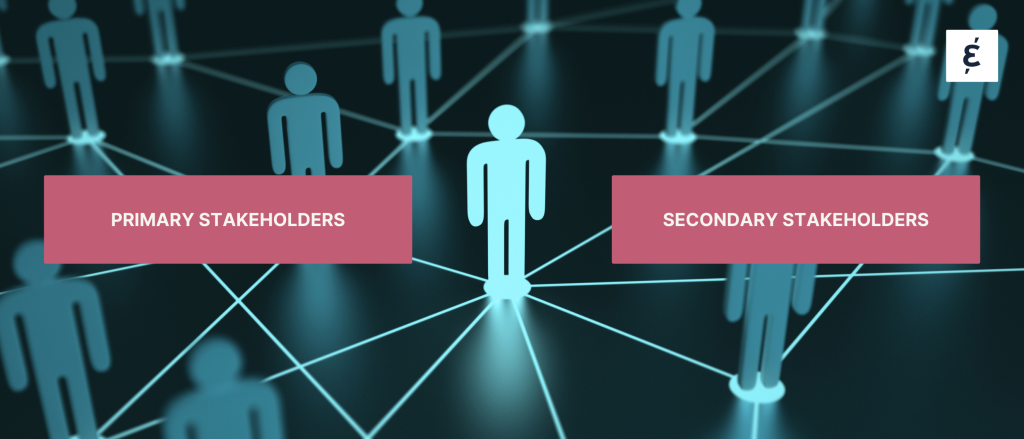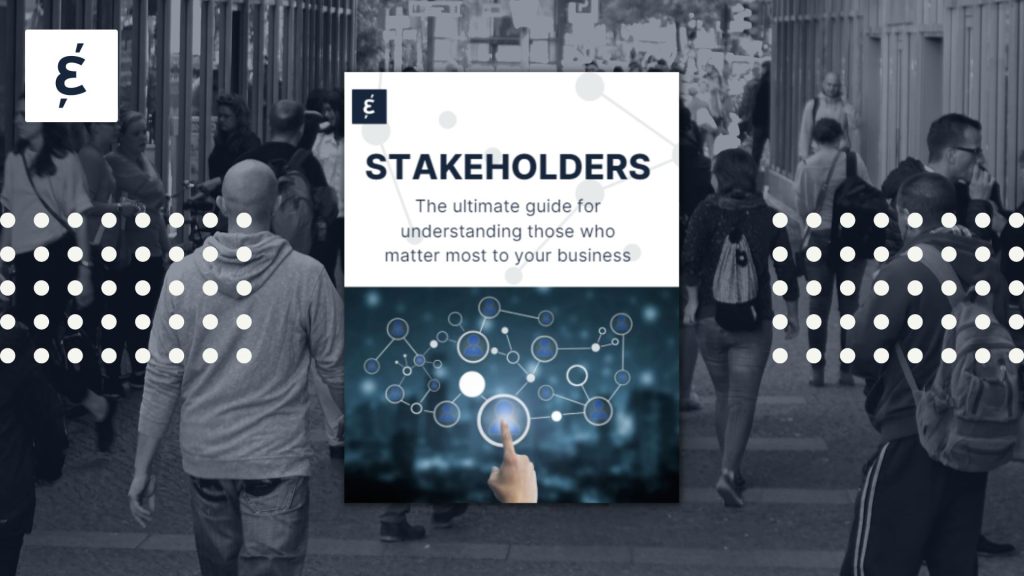

At the broadest definition of the term, stakeholders are those individuals or groups that have a vested interest in a company’s business performance and without whose support the company would cease to exist.
In the past decades, the delimitation of what constitutes a stakeholder has been erased. Any company operating in today’s complex business environment understands that the above stakeholder definition includes just about everybody.
Hence, the list below focuses on the most common stakeholders across industries.

There are basically two types of stakeholders – primary stakeholders and secondary stakeholders.
Primary stakeholders include employees, customers, suppliers, management, the Board of Directors, and shareholders/investors.

Employees exchange labor for salary and are most concerned with being paid and retaining their jobs. Other basic expectations include workplace safety and concern for employee health.
However, employees are also concerned with how they identify with corporate values and the overall purpose of the company, e.g., policies on equality, diversity, and environment.
Customers buy the company’s products and services. They primarily care about quality, value for money, customer service, and innovation.
In addition, customers are also concerned with the company’s legitimacy and license to operate, as well as its overall impact on society.
Suppliers deliver goods or services to the company.
They are interested in increasing their own business and are mostly concerned with getting a good price for their product or service, increasing the volume of engagement, and stability of interaction.
Management includes those with area or people responsibility inside the company. They are important for delivering on the strategy and ensuring buy-in from employees.
Managers care about clarity and transparency of the company’s overall direction, and about having good conditions for their team to deliver strong results, as well as being able to attract talent.
The board of directors is mainly interested in the successful performance of the business, focusing on increasing profits and attracting and retaining investors.
Alongside their legal responsibility, they are also concerned about governance and ethics issues.
Shareholders and investors are interested in getting a return on their investment in the company.
They are primarily concerned with increasing sales volume, cutting costs, and maximizing growth; however, they are also concerned with elements that could cause a sudden decrease in the value of their investment, i.e., crises related to things like compliance, fraud, CEO misconduct, environmental scandals, and others, meaning that they are also interested in proactive initiatives from the company on these matters.

Secondary stakeholders include (but are not limited to) the general public, government and regulators, talents, NGOs/interest groups, media, and key opinion leaders.
The general public encompasses all stakeholders but also represents a broadly defined separate entity that can also be referred to as ‘society’.
The public wants the company to do well by doing good, to abide by legislation, be a good employer, and be a good corporate citizen that takes responsibility for its role in society.
Those are people working at official bodies mostly concerned with the company’s obligations around legal compliance as a corporate entity and as an employer.
The relationship is both reactive and proactive from the corporate perspective, as influencing this stakeholder group can create better operational conditions for the company.
Talent represents potential employees within the company’s relevant professional fields.
This group typically has similar expectations to the company as existing employees; however, they are often more critical of the company as they do not understand the corporate strategy and targets to the same degree.
NGOs are typically non-profit entities focused on singular topics, often related to the environment, communities, and human rights.
Expectations from these groups are largely value-based. These groups can be politically and publicly active and vocal, often attracting media attention to issues related to CSR.
Media includes all communication outlets, journalists, and bloggers that are independent of the company.
Expectations from this stakeholder group can vary with the special interest of the media outlet in question.
Common for all are expectations of transparency, accessibility, clarity in communication, and availability of spokespeople for commentary. They often act as amplifiers – or multipliers – by broadening the reach of information to other stakeholders and drawing their attention.
These are the most important and vocal individual experts in fields of interest for the company.
They can be sector professionals, academics, analysts, politically active individuals or other visible or influential people in relevant ways.
These stakeholders are important to monitor as they often influence the opinions of others.
Any company’s stakeholder landscape should be considered dynamic. While some stakeholder groups will always remain relevant, new ones should be considered from time to time with certain events or topics making them relevant for the company to include in a measurement setup – in order to understand perceptions of these groups.
Below, we provide a guide on how to consistently map and monitor the relevant stakeholder universe in an effective way.
The first thing to do is to create a general overview of your company’s stakeholders. Define a list of consistently relevant stakeholders, as well as those who might occasionally become relevant. Divide them into primary and secondary stakeholders.
Not all stakeholders are of equal importance to the company. Therefore, you should determine the importance of your stakeholders by assessing them on two parameters: Power (Influence they have on the company’s ability to operate) and Interest (Impact of the company’s actions on them).
Detailing the current business context with each stakeholder is important to determine if the stakeholder in question should be monitored on an ongoing basis or around specific events.
Define how the stakeholders know the company and which topics they care about, how they might experience the topic from their perspective, and then how to mitigate a potential knowledge gap. Actively monitoring perceptions can help you understand if your efforts towards a certain stakeholder are serving to bridge any gaps in understanding.
Setting perception targets for stakeholders is important to internally agree on what success looks like within a defined period. It also helps in gauging how well your efforts are resonating with a particular group.
After creating a strong foundation for the tracking setup, it is time to measure perceptions. Here it is recommended to have consistency in tracking, reporting, and clearly communicating stakeholder insights internally so the tracking becomes a relevant tool to understand and improve the corporate reputation.
Reputation data should be continuous and digitally accessible so that many end-users within the company can benefit from these insights and integrate them with other continuous data sources. Make sure you build an open platform that all relevant markets and functions can access, and integrate it with your internal Business Intelligence tools if such are in existence.
Defining which stakeholders matter to you and why is a crucial exercise when setting up your reputation monitoring. Essentially, it is about mapping out your stakeholders and identifying their desired behavior towards the company, which would allow it to achieve its goals.
Once this is done, you should define the tracking setup in terms of the data points and KPIs you wish to track for each stakeholder, as well as how often you would like to review and assess results. Caliber believes that stakeholder monitoring should be ongoing and in real-time, which allows you to measure the impact of activities and events on stakeholder perceptions.

© 2024 Group Caliber | All Rights Reserved | VAT: DK39314320